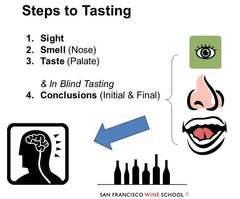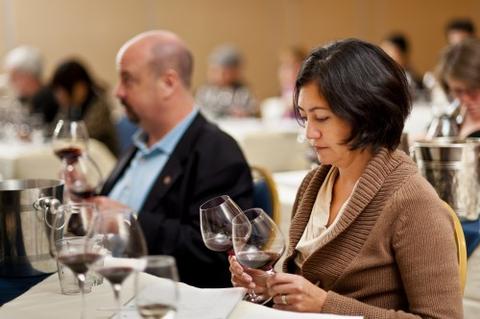One of the first things taught during the Court of Master Sommeliers Introductory Course is blind wine tasting, or more specifically the deductive tasting technique. They test blind tasting ability at the 2nd-4th levels of their exams (Certified, Advanced and Master Sommelier), but not at the Introductory. The Society of Wine Educators tests blind wine tasting for varietals and faults in their top exam, Certified Wine Educator (CWE). The Wine and Spirit Education Trust (WSET) tests tasting at their top 3 of 4 levels. The Master of Wine exam also tests blind wine tasting. Since the most prestigious global wine credential exams all include blind tasting it must be an important skill. Well, it does not hurt to re-evaluate standard models from time to time.
Testing one’s ability to detect wine flaws or imbalances makes sense. The difficulty lies in recreating faults in a consistent manner at levels in parts per million that are detectable without being too obvious. There are various recipes throughout the internet, but the Society of Wine Educators sells a wine fault kit that is the best of its kind. Even with the kits or best recipes, it is logistically challenging to test large numbers of students at various locations.
 Testing grape variety and geographic origin is becoming increasingly difficult as more grapes and regions become commercially significant in international markets. It is also a challenge to find typical examples of classic wines. Students are often taught that the wines of Chablis and Alsace are made with little to no oak influence, but there are producers in those regions who are downright heavy-handed in their use of new oak. California chardonnay is often heavily oaked, but more and more wineries are making un-oaked examples. Some would argue that there is a growing homogenization of wine into an international style. However, there are many regions and producers where typicity and tradition are valued.
Testing grape variety and geographic origin is becoming increasingly difficult as more grapes and regions become commercially significant in international markets. It is also a challenge to find typical examples of classic wines. Students are often taught that the wines of Chablis and Alsace are made with little to no oak influence, but there are producers in those regions who are downright heavy-handed in their use of new oak. California chardonnay is often heavily oaked, but more and more wineries are making un-oaked examples. Some would argue that there is a growing homogenization of wine into an international style. However, there are many regions and producers where typicity and tradition are valued.
 It will become more difficult every year for those preparing for exams and those conducting exams to find wines that are of the classic style for their region. Should credentialing organizations keep trying? There is a lot to learn from blind wine tasting beyond being a parlor trick of name that wine. Clues from the acid and alcohol levels to the fruit characteristics can help to deduce what kind of climate the grapes were grown in and potentially the vintage. Other markers will point to specific grape varietals, blends and winemaking techniques. Studying all of the regions of the world allows one to connect what they taste with what types of wines are made in each region. Tasting blindly helps the taster to focus on every attribute of every wine. This makes it easier to describe wines to customers. It also often leads wine buyers to stock the shelves or lists based on what is in the bottle rather than what is on the label. Blind wine tasting exams reinforce theoretical knowledge and connect theory to the real world. Being great at blind tasting does not necessarily make one a better wine sales or service professional, but it is one measure of your knowledge and how you put it to use. Despite the challenges, blind wine tasting exams are well worth the effort.
It will become more difficult every year for those preparing for exams and those conducting exams to find wines that are of the classic style for their region. Should credentialing organizations keep trying? There is a lot to learn from blind wine tasting beyond being a parlor trick of name that wine. Clues from the acid and alcohol levels to the fruit characteristics can help to deduce what kind of climate the grapes were grown in and potentially the vintage. Other markers will point to specific grape varietals, blends and winemaking techniques. Studying all of the regions of the world allows one to connect what they taste with what types of wines are made in each region. Tasting blindly helps the taster to focus on every attribute of every wine. This makes it easier to describe wines to customers. It also often leads wine buyers to stock the shelves or lists based on what is in the bottle rather than what is on the label. Blind wine tasting exams reinforce theoretical knowledge and connect theory to the real world. Being great at blind tasting does not necessarily make one a better wine sales or service professional, but it is one measure of your knowledge and how you put it to use. Despite the challenges, blind wine tasting exams are well worth the effort.
To learn more about blind wine tasting check out the following classes:
- Intro to Blind Tasting
- Tasting, Chemistry & Flaws
- Wine Dojo
- Intermediate Blind Tasting
- Advanced Blind Tasting
For the super-geeky among you, check out my video on the 5th and 6th tastes, umami and kokumi.
See all our upcoming classes and events at https://sanfranciscowineschool.com/

